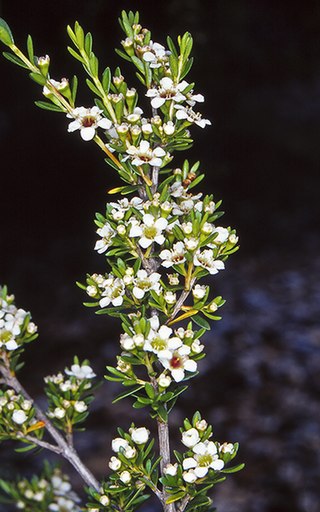
Verticordia helichrysantha, commonly known as coast featherflower or Barrens featherflower, is a flowering plant in the myrtle family, Myrtaceae and is endemic to the south-west of Western Australia. It is a small, woody, open-branched shrub with crowded, linear leaves and small yellow flowers from May to September.

Hypocalymma angustifolium, commonly known as white myrtle, or pink-flowered myrtle, is a species of flowering in the myrtle family Myrtaceae, and is endemic to the south west region of Western Australia. The Noongar peoples know the plant as koodgeed or kudjidi. It is an erect, multi-stemmed shrub with narrowly linear leaves, white or pale pink flowers.

Agonis grandiflora is a species of flowering plant in the family Myrtaceae, and is endemic to the southwest of Western Australia. It is an erect, often straggly shrub with sessile, linear leaves, white flowers often suffused with pink and broadly cup-shaped capsules.

Agonis undulata is a species of flowering plant in the family Myrtaceae, and is endemic to the Fitzgerald River National Park in the south of Western Australia. It is an erect shrub with more or less sessile, egg-shaped leaves with the narrower end towards the base, white flowers, and broadly cup-shaped capsules.
Baeckea pygmaea is a species of flowering plant in the family Myrtaceae and is endemic to the south-west of Western Australia. It is a slender and erect or spreading shrub with narrowly egg-shaped to almost linear leaves and small white flowers with 12 to 25 stamens.

Darwinia pauciflora is a species of flowering plant in the family Myrtaceae and is endemic to the southwest of Western Australia. It is an open to bushy shrub with oblong to egg-shaped leaves and heads of erect, creamy-white and pink flowers.

Calytrix achaeta, commonly known as the white-flowered turkey bush, kerosene wood or fringe-myrtle, is a species of flowering plant in the myrtle family Myrtaceae and is endemic to north-western Australia. It is a shrub or tree with hairy branchlets, egg-shaped, linear or lance-shaped leaves, and white to cream-coloured flowers with 12 to 18 stamens in a single row.

Hypocalymma cordifolium is a species of flowering plant in the myrtle family Myrtaceae, and is endemic to the south west of Western Australia. It is usually an low-growing shrub, but is sometimes erect, with winged stems, heart-shaped leaves arranged in opposite pairs, white or pale pink flowers mostly arranged in pairs in leaf axils, and fruit containing pearly white or pale brown seeds.

Hypocalymma elongatum is a species of flowering plant in the myrtle family Myrtaceae, and is endemic to the south west of Western Australia. It is a large, bushy shrub with linear leaves more or less triangular in cross section, and pink flowers arranged in pairs in leaf axils with 30 to 50 stamens.
Hypocalymma gardneri is a species of flowering plant in the myrtle family Myrtaceae, and is endemic to the south west of Western Australia. It is a widely spreading subshrub, with linear leaves and yellow flowers arranged in pairs in leaf axils, with 80 to 105 stamens in several rows.
Micromyrtus imbricata is a species of the family Myrtaceae and is endemic to the south of Western Australia. It is a slender, erect shrub with broadly egg-shaped leaves, white, pink or red-tinged flowers 4–5 mm (0.16–0.20 in) in diameter, and 10 stamens.

Babingtonia grandiflora, commonly known as the large flowered babingtonia, is a species of flowering plant in the family Myrtaceae and is endemic to the southwest of Western Australia. It is a shrub with erect or arching stems, linear leaves and white or pale pink flowers usually arranged singly in leaf axils, each flower with 11 to 25 stamens.

Thryptomene parviflora is a species of flowering plant in the family Myrtaceae and is endemic to Queensland. It is a slender, erect shrub with decussate, linear to egg-shaped leaves with the narrower end towards the base, and flowers with five petals and five stamens arranged singly in leaf axils.
Hibbertia juncea is a species of flowering plant in the family Dilleniaceae and is endemic to the Northern Territory. It is a small shrub with leaves reduced to minute scales, and white to cream-coloured or pink flowers arranged in leaf axils with seven to ten stamens.

Hibbertia mucronata is a species of flowering plant in the family Dilleniaceae and is endemic to the south of Western Australia. It is an erect shrub with hairy branches, crowded, thick, tapering linear leaves ending in a sharp point, and golden yellow flowers with five stamens fused at their bases, all on one side of two densely hairy carpels.

Baeckea latifolia is a species of flowering plant in the family Myrtaceae and is endemic to south-eastern continental Australia. It is a shrub with broadly elliptic leaves and small white flowers with six to eight stamens.
Daviesia pachyloma is a species of flowering plant in the family Fabaceae and is endemic to the south-west of Western Australia. It is an erect, bushy or spreading shrub with zigzagging branches, sharply-pointed, narrowly elliptic to linear phyllodes, and yellow and red flowers.

Styphelia racemulosa is a species of flowering plant in the heath family Ericaceae and is endemic to the south-west of Western Australia. It is an erect, rigid shrub with linear leaves and white, tube-shaped flowers usually arranged in pairs or threes in leaf axils.

Micromyrtus hexamera is a species of flowering plant in the myrtle family, Myrtaceae and is endemic to Queensland. It is a shrub with erect or spreading branchlets, overlapping linear leaves, and white flowers arranged singly in leaf axils with 5 stamens in each flower.

Calytrix arborescens is a species of flowering plant in the myrtle family Myrtaceae and is endemic to the Northern Territory. It is a shrub or tree with egg-shaped leaves and clusters of white flowers with 45 to 60 white stamens in 2 rows.














